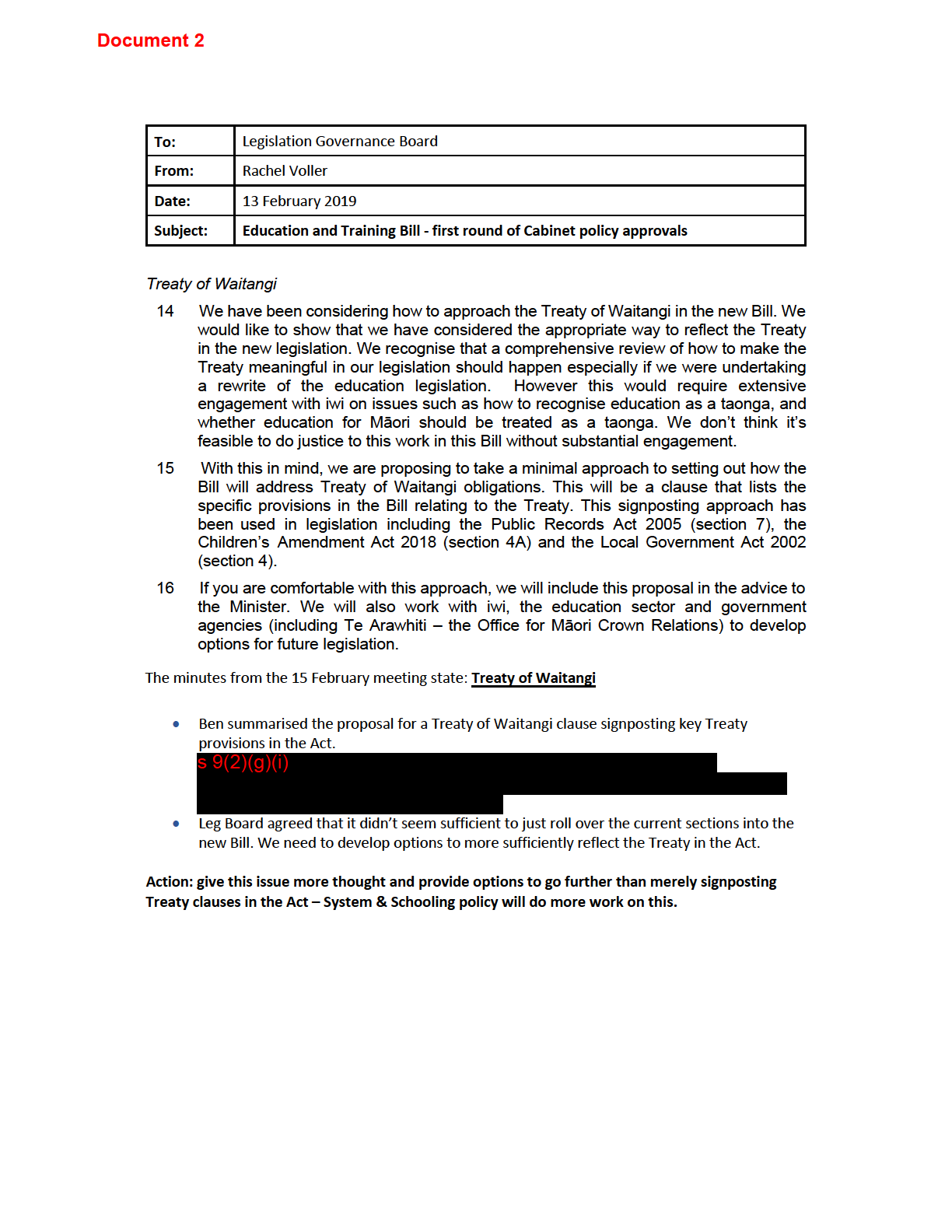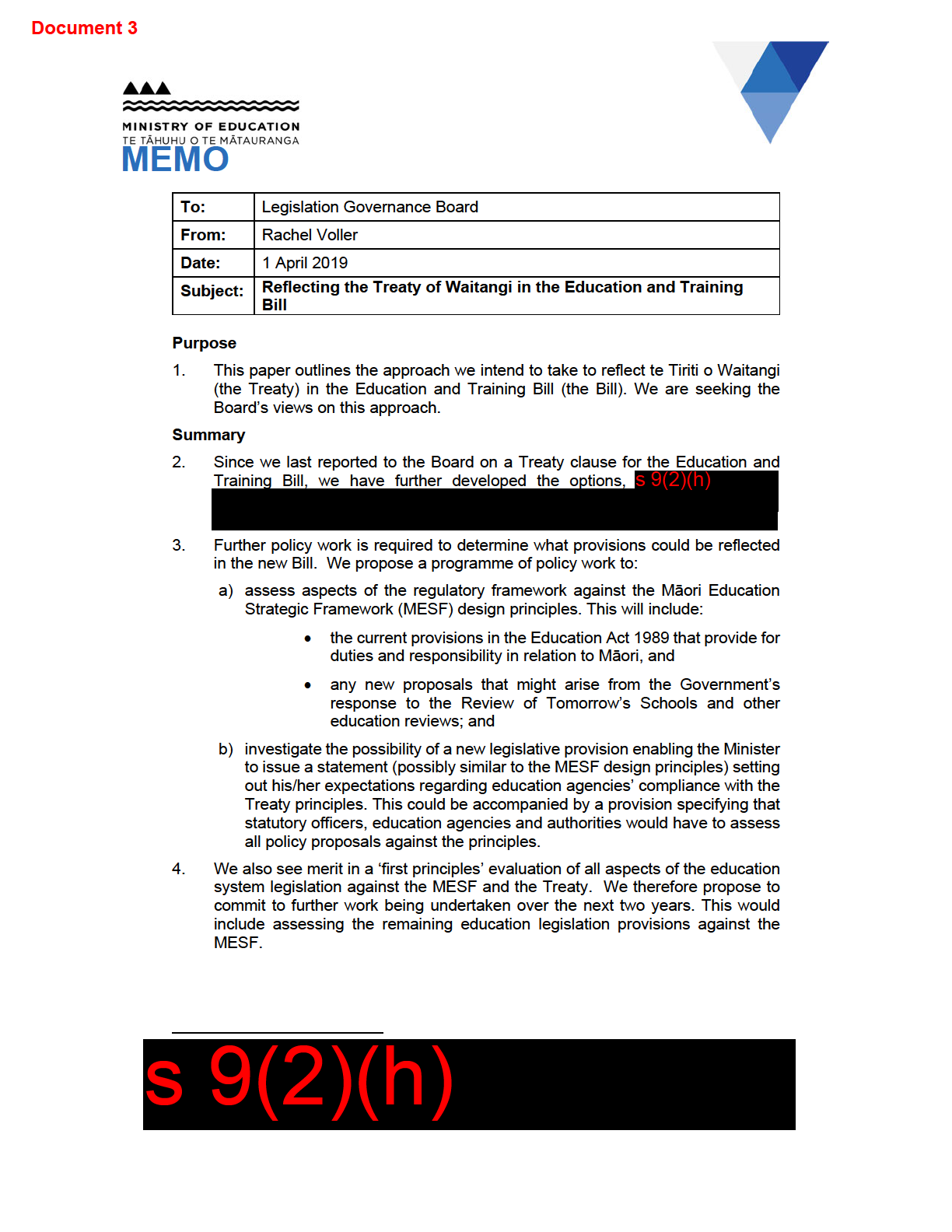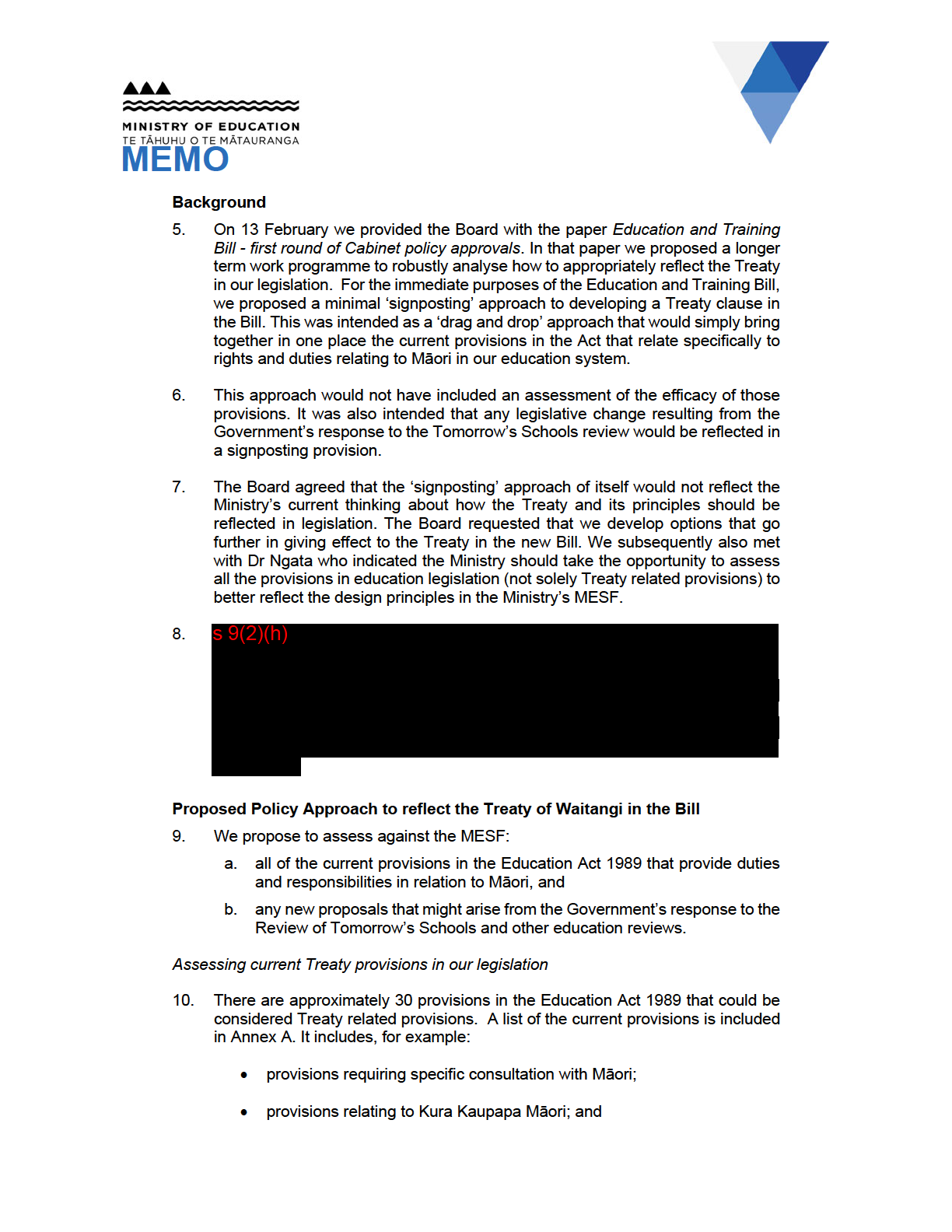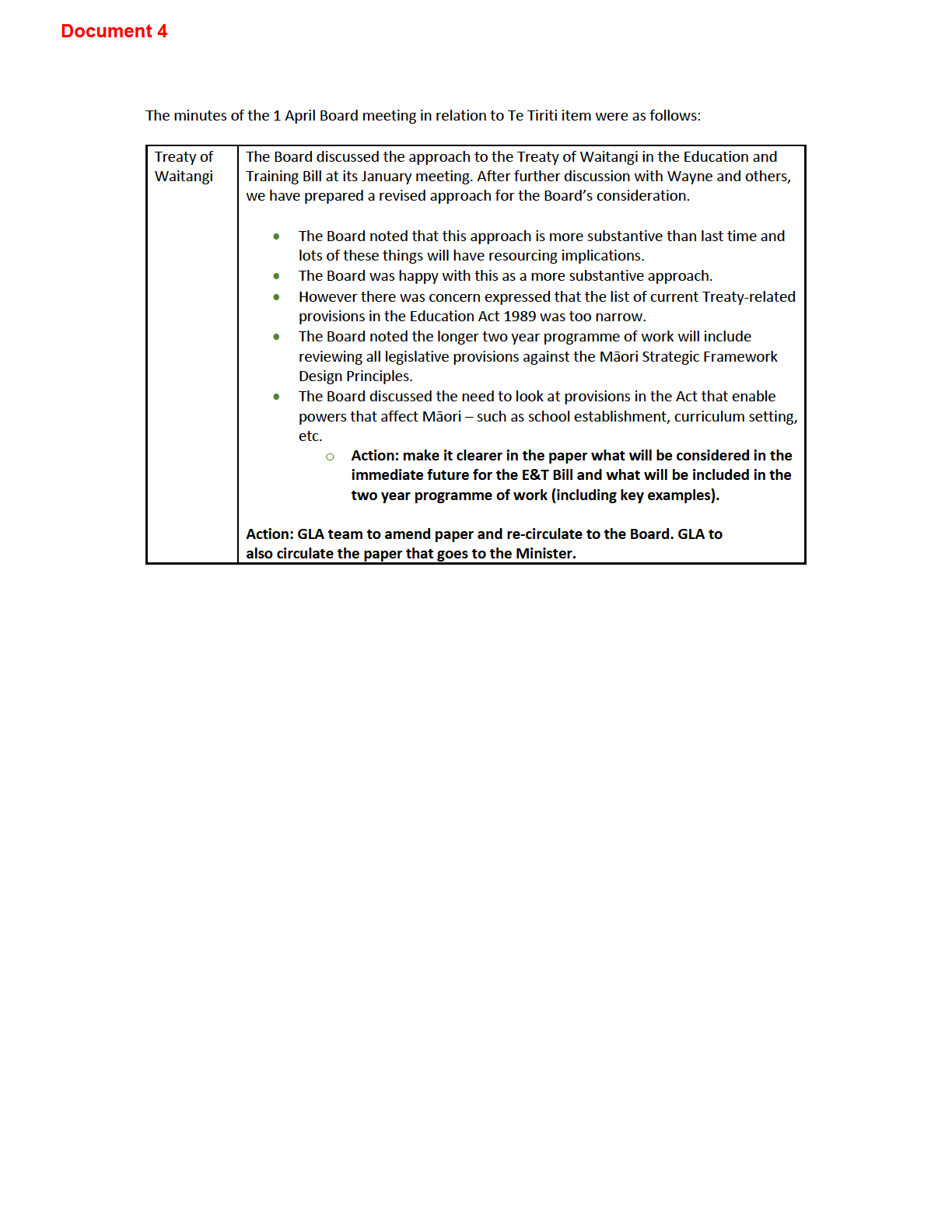


 Document 1
Draft high-level structure for Education and Training Bill
Notes
Document 1
Draft high-level structure for Education and Training Bill
Notes
Released
The table below sets out a high-level structure showing possible Part headings,
subpart headings, suggested content and comments. Content can be divided up
within subparts by the use of cross-headings (centred, italicised headings).
Key to whether review required:
This subject area is affected by reviews.
This subject area is not affected by reviews but policy work is required.
under
Content can be moved over from current legislation largely unchanged (‘cut and pasted’).
Education and Training Bill 2019/2020 Part 1, Preliminary provisions 1.6 Treaty of Waitangi the
A possible provision indicating where
The Cabinet Manual requires Ministers to
specific duties are included to
confirm in the LEG paper that the bill
recognise the
Treaty of Waitangi
complies with the principles of the Treaty
Official
(see, for example, s 7 Public Records
of Waitangi. Consequently some analysis
Act 2005)
of impacts on Māori interests will be
required. The 1989 Act includes a few
references to the Treaty of Waitangi. For
example, a Board of Trustees must take
all reasonable steps to act in a manner
that is consistent with the principles of the
Information
Treaty (Sch 6, cl 16).
The minimum for a bill to be developed
next year would be to include a provision
which lists or indexes the sections of the
Act that recognise the Treaty of Waitangi.
An example of this is s7 of the Public
Records Act 2005. A more comprehensive
review of Treaty implications, including, for
example, a consideration of whether
education is a taonga, is not on the current
work programme, so would need to occur
later (see section 4 of the Te Ture mō Te
Act
Reo Māori Act 2016, which recognises
Māori language as a taonga of iwi and
Māori who are the kaitiaki of the Māori
1982
language).

Released
under
the Official
Information
Act 1982

Released
under
the Official
Information
Act 1982

Released
under
the Official
Information
Act 1982
 MEMO
MEMO
Released general provisions relating to the availability of teaching in te reo and with
tikanga Māori.
11. Some of these provisions appear, prima facie, to be inconsistent with the MESF
design principles. For example, the current requirement for a school board to
only need to take
all reasonable steps to provide instruction in tikanga Māori and
te reo Māori when a parent asks is arguably inconsistent with the principle of tino
rangatiratanga (the mandate for Māori exercising their authority and agency in
education). We will need to work through how to strengthen requirements such
as these in our legislation, and how to manage practical considerations such as
under
funding implications, the availability of teachers with relevant experience and the
ability for school boards to deliver a higher level of service.
Assessing Tomorrow’s schools proposals against the MESF
12. In respect of any new proposals developed through the Government’s responses
the
to Tomorrow’s Schools, we will work with the Tomorrow’s Schools response
team to assess the policy proposals against the design principles.
Official
13. For example, should new education entities or hubs be proposed, we will need
to consider how Māori will be enabled to exercise authority and agency in each
of these entities. Another example will be for us to consider, as part of any new
disputes resolution process, how to ensure Mana Tikanga and Mana
Whakapapa principles are enabled across an end-to-end process (i.e. how can
we ensure cultural responsiveness to Māori and facilities in te reo in new
mediation or independent tribunal processes).
Information
Giving legislative effect to a Ministerial direction to education agencies on Treaty
principles
14. We are investigating the possibility of a new legislative provision enabling the
Minister to issue a statement or direction to set out his/her expectations for
education agencies’ compliance with a set of MESF principles. Such a Ministerial
statement could include reference to the Ministry’s MESF design principles, for
example. This could be accompanied by a provision specifying that statutory
officers, education agencies and authorities must assess all policy proposals
against the principles.
Act
15. Such a statement could be similar to the NELP, and be Gazetted by the Minister.
Further work beyond this year’s Bill
1982
16. Even with the work described above, we recommend committing to a more
comprehensive review of how the MESF design principles are reflected in
education legislation. We anticipate that this would include the establishment of
a cross-Ministry and cross-agency working group that would undertake work for
up to two years to determine how to best give effect to the Treaty in education
legislation.
 MEMO
MEMO
Released
Next Steps
17. We propose, subject to the Board’s feedback:
over the next week to prepare an Education Report informing the
Minister of our approach described above to reflect the Treaty in the
Bill;
to undertake an analysis of the current treaty related education
legislation provisions as set out in Annex A;
under
to report back to the Board on the analysis of existing legislation prior
to the development of policy proposals;
to work with the Tomorrow School’s response team to ensure that the
development of advice is consistent with the MESF design principles;
the
and
further investigate the possibility of enabling the Minister to issue a
Official
statement with which education agencies would have to comply when
making recommendations regarding policy options.
Information
Act 1982

Released
MEMO
under
Annex A: References to Treaty of Waitangi and relevant concepts in the Education Act 1989
The following is a full list of provisions in the Education Act 1989 which have Treaty of Waitangi implications. For some of these provisions, the Ministry of
Education is not the lead policy agency, for example, sections 210-214 relate to land law and Treaty settlement law. We are not considering reassessing
those provisions.
the
Provision
What it does?
Application of design
principles
Education Act 1989
Official
Section Title
1A Early The objectives of the system for education and learning that is provided for in the specified
childhood
Parts (that is, early childhood and compulsory education) include to instil in each child and
s 9(2)(g)(i)
and
young person an appreciation (i) of the importance of the inclusion within society of different
compulsory
groups and persons with different personal characteristics: (ii) the diversity of society: (iii)
education:
cultural knowledge, identity, and the different official languages: (iv) the Treaty of Waitangi and
statement of
te reo Māori.
Information
National
Education
4A The Minister must make reasonable efforts to consult children and a range of national
and Learning bodies including (i) national bodies representing the interests of Māori education organisations
Priorities
Act 1982

Released
MEMO
under
Provision
What it does?
Application of design
principles
Section Title
11H Process
for
(1) If the Secretary gives a written notice to a State school that there is, or is likely to be,
developing
overcrowding at the school, the board of the school must develop an enrolment scheme for the s 9(2)(g)(i)
the
and adopting school.
enrolment
(2) A board may not begin developing an enrolment scheme unless it has received a written
scheme
notice of the type referred to in subsection (1).
[(3) Requirement for board to consult school communities]
Official
(4) In addition to the consultation required by subsection (3),— (a) the board of a Kura Kaupapa
Māori must consult with the persons and organisations that the board believes have an interest
in fostering the school’s adherence to Te Aho Matua and any special characteristics set out in
the school’s charter:
11PB
Enrolement
(1) Sections 11A to 11PA apply to Kura Kaupapa Māori, designated character schools, State
schemes of
integrated schools, State schools that are accredited as enrolling communities of online
Information
certain State
learning, and special schools, and to their enrolment schemes, subject to the following
schools
modifications… (d) in the case of a Kura Kaupapa Māori, the application of the sections must
not result in inconsistency with section 156; and… (te reo is the principal language of
instruction; school will operate in accordance with Te Aho Matua (s 155A)
61(3)
School
A school charter must contain the following sections: (a) a section that includes— (i) the aim of
charter
developing, for the school, policies and practices that reflect New Zealand’s cultural diversity
and the unique position of the Māori culture; and (ii) the aim of ensuring that all reasonable
steps are taken to provide instruction in tikanga Māori (Māori culture) and te reo Māori (the
Māori language) for ful -time students whose parents ask for it:
Act 1982

Released
MEMO
under
Provision
What it does?
Application of design
principles
Section Title
(1) Before applying any of the interventions in this Part to a Kura Kaupapa Māori, the Secretary
78T Application
of
must consult with te kaitiaki o Te Aho Matua (as defined in section 155B).
interventions
s 9(2)(g)(i)
to Kura
(2) Subsection (1) applies only to Kura Kaupapa Māori that are required by their charters to
the
Kaupapa
operate in accordance with Te Aho Matua.
Māori
Part 7A (78H – 78T) deals with interventions in schools to address risks to the operation of
schools or risks to student welfare or educational performance.
Official
154A
Minister may
(1) The Minister may, … after consultation with the board of the affected school, do any of the
redesignate,
following: (a)
designate a State school that is not a Kura Kaupapa Māori or a designated
or remove
character school as a Kura Kaupapa Māori or a designated character school: (b)
remove the
designation
designation of a Kura Kaupapa Māori and redesignate it as a designated character school: (c)
from, schools remove the designation of a designated character school and redesignate it as a Kura Kaupapa
Māori: (d)
remove the designation of a Kura Kaupapa Māori or a designated character school
while keeping the school established as a State school. Information
(4) Section 156 applies in respect of a school that is, or is to be, redesignated as a Kura Kaupapa
Māori in the same way as it would apply if the school were being established as a Kura Kaupapa
Māori.
(5) No school may have its designation as a Kura Kaupapa Māori removed unless the Minister
has first consulted with te kaitiaki o Te Aho Matua (as identified under section 155B).
(6) No State school may be designated as a Kura Kaupapa Māori unless the Minister has first
consulted with te kaitiaki o Te Aho Matua on the ability of the school to operate in accordance
with Te Aho Matua (as defined in section 155A).
(7) Section 156 applies in respect of a school that is, or is to be, redesignated as a designated
character school in the same way as it would apply if the school were being established as a
Act
designated character school.
1982

Released
MEMO
under
Provision
What it does?
Application of design
principles
Section Title
155 Kura
When establishing a State school as a designated character school under sections 156 and
Kaupapa
156AA, the Minister may also designate that designated character school as a Kura Kaupapa
s 9(2)(g)(i)
Māori
Māori.
the
155A
Te Aho
(1) Te Aho Matua is a statement that sets out an approach to teaching and learning that applies
Matua
to schools designated under section 155. (2) The official version of Te Aho Matua is the
Official
statement (including any gazetted amendments) in te reo Māori that is— (a) prepared by te
kaitiaki o Te Aho Matua (as defined in section 155B); and (b) published in the Gazette under the
authority of the Minister.
155B
Te kaitiaki o
Te kaitiaki o Te Aho Matua is the body commonly known as Te Runanga Nui o Nga Kura
Te Aho
Kaupapa Māori o Aotearoa, being the most suitable to be responsible for determining the
Matua
content of Te Aho Matua, and for ensuring that it is not changed to the detriment of Māori.
Information
155C 155C
After the commencement of the Education (Te Aho Matua) Amendment Act 1999, the Minister
Application of may establish a school as a Kura Kaupapa Māori only in accordance with section 155 as
section 155
substituted by that Act.
Act 1982

Released
MEMO
under
Provision
What it does?
Application of design
principles
Section Title
(1) In this section and section 155E,— existing Kura means a Kura Kaupapa Māori established
155D
Provisions
applying to
under section 155 before the commencement of the Education (Te Aho Matua) Amendment Act s 9(2)(g)(i)
Kura Kaupapa
1999; new section 155 means section 155 as substituted by the Education (Te Aho Matua)
the
Māori
Amendment Act 1999.
established
(2) After the commencement of this section, existing Kura remain established as Kura Kaupapa
before
commenceme
Māori even if they would not be entitled to be established under new section 155.
Official
nt of Education (3) Section 156(6)(a)(i), (8), and (10) applies to all existing Kura.
(Te Aho
Matua)
4) In relation to an existing Kura other than one acknowledged under section 155E, the Minister
Amendment
may from time to time, after consultation with the board of the Kura, by notice in the
Gazette,
Act 1999
amend— (a) the aims, purposes, and objectives of the Kura; or (b) the constitution of the board.
(5) In relation to an existing Kura other than one acknowledged under section 155E, the board
of the Kura may refuse to enrol any person whose parents do not accept that the school operates
in accordance with the school’s aims, purposes, and objectives.
Information
155E
Acknowledgm
The Minister may from time to time, after consultation with the board of an existing Kura, by
ent of adoption notice in the
Gazette, acknowledge that the Kura operates in accordance with Te Aho Matua,
of Te Aho
and must, in the notice,—(a) replace the aims, purposes, and objectives of the Kura by a
Matua
statement that the school will operate in accordance with Te Aho Matua (as referred to
in section 156AA(3)(a)(i )); and (b)
summarise any special characteristics of the school (as
referred to in section 156AA(3)(a)(iii)).
(2) On publication of a notice under subsection (1), the Kura becomes subject to all the relevant
provisions of section 156
Act 1982

Released
MEMO
under
Provision
What it does?
Application of design
principles
Section Title
155F
Protection of
(1) No registered school may use the term Kura Kaupapa Māori in its name unless the school is
term Kura
established under section 156.
s 9(2)(g)(i)
Kaupapa
the
Māori
(2) Subsection (1) does not apply to a registered school that, immediately before the
commencement of this section, is not established under section 155 but uses the term Kura
Kaupapa Māori in its name.
Official
156
Designated
(4) The Minister may not establish a school as a designated character school unless satisfied
character
that, if the school is established,— (a) for a school that will also be designated a Kura Kaupapa
schools
Māori under section 155,— (i) te reo Māori will be the principal language of instruction at the
school; and (ii)
the school will operate in accordance with Te Aho Matua (as defined in section
155A):
(5) The Minister may not also designate a designated character school as a Kura Kaupapa
Māori unless he or she has first consulted te kaitiaki o Te Aho Matua on the ability of the school
Information
to operate in accordance with Te Aho Matua.
(6) The board of a designated character school must ensure,— (a) for a Kura Kaupapa Māori,
that— (i) te reo Māori is the principal language of instruction at the school; and (ii) the school
operates in accordance with Te Aho Matua:
(7) A designated character school that is a Kura Kaupapa Māori may have other special
characteristics that give it a particular character (its special characteristics)
(9) A board of a designated character school may refuse to enrol students whose parents do
not accept,— (a)
for a Kura Kaupapa Māori, that the school operates in accordance with Te Aho
Matua: (b)
for any other type of designated character school, that the school operates
consistently with its different character.
Act 1982

Released
MEMO
under
Provision
What it does?
Application of design
principles
Section Title
(1) The Minister may, by notice in the
Gazette when establishing a State school, designate
156AA
Process for
the school as a designated character school (
see section 156) and (if applicable) also
s 9(2)(g)(i)
establishing
designate a school as a Kura Kaupapa Māori (
see section 155).
designated
the
character
(2) Before doing so, the Minister must be satisfied of the matters in section 156(4) and have
schools
undertaken consultation under section 156(5) (as relevant in each case).
(3) The notice establishing a designated character school must,— (a) for a Kura Kaupapa
Official
Māori,— (i) specify the name of the school, which must at all times begin with the words “Te
Kura Kaupapa Māori o”; and (ii)
state that the school will operate in accordance with Te Aho
Matua; and (i i) summarise any other special characteristics of the school:
156B
Restrictions on
(1) A Kura Kaupapa Māori established after the commencement of the Education (Te Aho
mergers in
Matua) Amendment Act 1999 may not merge or be merged with another Kura Kaupapa
certain cases
Māori or other school unless the schools involved in the merger— (a) operate in accordance
with Te Aho Matua; and (b) use te reo Māori as the principal language of instruction.
Information
(2) Any other Kura Kaupapa Māori may merge with another school only if both schools use
te reo Māori as the principal language of instruction and have the same aims, purposes, and
objectives.
171B
Matters to be
(1) It is desirable that the council of an institution should, so far as is reasonably practicable,
considered
reflect— (a) the ethnic and socio-economic diversity of the communities served by the
when appointing institution; ….
members [to
TEIs]
(2) When appointing members of a council, the Minister or council must have regard to
subsection (1), but— (a) must ensure that at least 1 member of the council is Māori; and
Act 1982

Released
MEMO
under
Provision
What it does?
Application of design
principles
Section Title
181
Duties of
It is the duty of the council of an [tertiary] institution, in the performance of its functions and
the
s 9(2)(g)(i)
councils
the exercise of its powers,— (b) to acknowledge the principles of the Treaty of Waitangi:
210
Māori land
The submission in respect of any land or interest in land of a claim under section 6 of the
claims
Treaty of Waitangi Act 1975 does not prevent the transfer of that land or of any interest in
Official
that land or of that interest in land— (a) by the Crown to an institution; or (b) by an institution
to any other person.
Resumption of
Where the Waitangi Tribunal has, under section 8A(2)(a) of the Treaty of Waitangi Act
212
land on
1975, recommended the return to Māori ownership of any land or interest in land transferred
recommendatio
to an institution under section 206 or vested in an institution by an Order in Council made
ns of Waitangi
under section 215, that land or interest in land shall, if the recommendation has been
Tribunal
confirmed with or without modifications under section 8B of that Act, be resumed by the
Information
Crown in accordance with section 213 of this Act and returned to Māori ownership.
213
Resumption of
The power conferred by this section does not include the power to acquire or take and to
land to be
hold under section 28 of the Public Works Act 1981 any interest in land described in section
effected under
8A(6) of the Treaty of Waitangi Act 1975.
Public Works
Act 1981
214
Resumption of
Upon its resumption pursuant to subsection (1), the land or interest in land shall be dealt
wahi tapu
with in accordance with an agreement made between the Crown and the relevant tribe or, if
they fail to agree, in accordance with any recommendation of the Waitangi Tribunal
pursuant to an application made under section 6 of the Treaty of Waitangi Act 1975.
Act
1982

Released
MEMO
under
Provision What
it
does?
Application of design
principles
Section Title
222AD
Matters to be
It is desirable in principle— (a) that the council of a designated polytechnic should include
considered
Māori; and (b) that, so far as is possible, the council of a designated polytechnic should reflect s 9(2)(g)(i)
when
the
the ethnic and socio-economic diversity of the community it serves.
apppointments
made [to
polytechnic
councils]
Official
253C
Minister may
(2A) A wananga may apply to the Minister for consent to describe itself using the term
consent to use university, col ege of education, polytechnic, or institute of technology. (3) Before deciding
of certain
whether to grant consent under subsection (2) or (2A), the Minister must— (e) in the case of a
terms in name
wananga, consult with such persons or bodies who are knowledgeable in āhuatanga Māori
or description
(Māori tradition) and tikanga Māori (Māori custom) within a kaupapa Māori pedagogy as the
of registered
establishment
Minister considers appropriate.
or wananga
Information
Schedule 6 Interpretation In this schedule, unless the context otherwise requires,— (a) the parents, families, and
(clause 1)
whānau of the school’s students; and (b
) the Māori community associated with the school; and
(c
) any other person, or group of persons, who the board considers is part of the school
community for the purposes of the relevant provision
Act 1982

Released
MEMO
under
Provision What
it
does?
Application of design
principles
Section Title
Schedule 6 Cultural
A board must take all reasonable steps to ensure that the policies and practices for its school
s 9(2)(g)(i)
(clause 16)
diversity,
reflect New Zealand’s cultural diversity and the unique position of the Māori culture. (2) In
Treaty of
performing its functions and exercising its powers, a board must take all reasonable steps to
the
Waitangi,
act in a manner that is consistent with the principles of the Treaty of Waitangi. (3) Without
tikanga
limiting subclauses (1) and (2), a board must take all reasonable steps to provide instruction in
Māori, and te tikanga Māori (Māori culture) and te reo Māori (the Māori language) for full-time students
Official
reo Māori
whose parents ask for it.
Schedule
Governance
When considering whether to appoint a member of the Teaching Council, the Minister must—
21
provisions of
….(4)(b) have regard to the collective skills, experience, and knowledge making up the overall
Teaching
composition of the Teaching Council, including (but not limited to) the candidate’s knowledge
Council
and experience in any of the following areas:… (v) understanding of the partnership principles
Information
(clause 1)
of the Treaty of Waitangi.
Act 1982

Released
under
the Official
Information
Act 1982



















